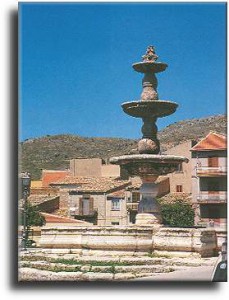Sanctuary of Santa Rosalia 1760:
As part of our history, I have included the following:
 A short distance from the small village of Santo Stefano di Quisquina is the Sanctuary of Santa Rosalia (1760).
A short distance from the small village of Santo Stefano di Quisquina is the Sanctuary of Santa Rosalia (1760).
It is almost cave like and the remains of Santa Rosalia are buried there. Saint Rosalia, also called La Santuzza or “The Little Saint”, is the patron saint of Palermo, Italy.
Santa Rosalia clearly holds a special place in the hearts of many Sicilians, who have affectionately nicknamed her La Santuzza, the little saint. During the first week of June every year in Santo Stefano Quisquina, there is a special celebration to commemorate her miraculous intervention that saved Palermo from the Black Plague. Rosalia was the daughter of Duke Sinibaldo, Lord of the Quisquina and the Roses, who was a cousin of King William II of Sicily. Like Saint Francis of Assisi, Rosalia turned her back on a life of ease and chose to devote herself to prayer and solitude. The legend says that in 1159 she retired to a hermetic existence in a remote cave on Monte Pellegrino, the rocky cliff high above the Bay of Palermo. Nothing was heard from her again until 1624, when the plague arrived in Sicily.
Salvation to Sicily came in the unexpected form of La Santuzza, who appeared in a vision to a hunter lost on Monte Pellegrino. “Don’t worry,” she said “I will protect you and I will protect the city”. She revealed to him the site of the cave in which she had lived as a hermit and told him to go back to Palermo and alert the archbishop and rulers of the city. The hunter did as he was instructed, and those leaders found her remains and displayed them through the streets of Palermo. Within three days, the plague ended, and she was proclaimed patron saint of the city.
History of Santo Stefano Quisquina
Santo Stefano Quisquina (Zip Code 92020) is 76 Km. distant from Agrigento, the province it belongs to, 110 Km. from Caltanissetta, 224 Km. from Catania, 136 Km. from Enna, 320 Km. from Messina, 95 Km. from Palermo.
 The municipality counts 5.640 inhabitants, its surface measures 8.592 hectares, and its population density is of 66 inhabitants per square kilometre. The Town Hall is located in via Roma.
The municipality counts 5.640 inhabitants, its surface measures 8.592 hectares, and its population density is of 66 inhabitants per square kilometre. The Town Hall is located in via Roma.
Situated on a land rich of water springs, Santo Stefano Quisquina boasts a conspicuous production of olives, cereals, citrus fruits, almonds, and honey.
Cattle breeding and sheep farms are remarkable, and the deriving dairy products can be tasted during the annual Cheese Festival, held in the month of May. The local typical handicraft production includes wooden, wrought iron, and aluminum objects.
Since its origins, the town’s name was Santo Stefano, and the appositive “Quisquina” was added because of the homonymous mountain’s proximity.
Affinita Elettive
 The suburb was founded approximately in 1300, during the reign of Federico II of Aragona, and belonged to Lord Giovanni Caltagirone.
The suburb was founded approximately in 1300, during the reign of Federico II of Aragona, and belonged to Lord Giovanni Caltagirone.
Afterwards, it was bestowed to nobleman Ruggero Sinisi. In 1396, the town was acquired by the Larcan family, who ruled until the XVI century. The town’s last lords were the Ventimiglia, who reigned until the abolition of feudality.
The most outstanding monuments are the Sanctuary of St. Rosalia alla Quisquina erected in 1760, and the XVI century Chiesa Madre dedicated to S. Nicola di Bari, that preserves a wooden engraved Crucifix.
Saint Rosalia, also called La Santuzza or “The Little Saint”, is the patron saint of Palermo, Italy,
